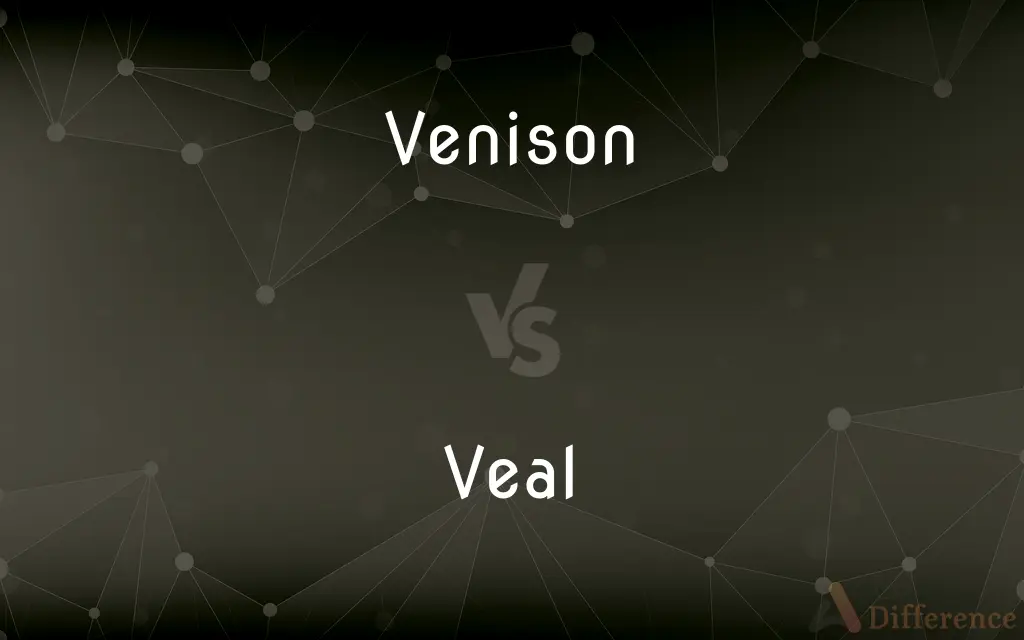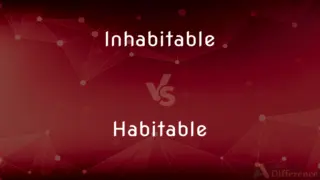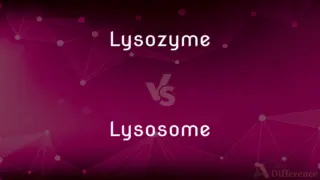Venison vs. Veal — What's the Difference?
By Tayyaba Rehman — Updated on October 11, 2023

Difference Between Venison and Veal
Table of Contents
ADVERTISEMENT
Key Differences
Venison is the culinary term used to describe the meat of deer. On the other hand, Veal is the meat derived from young calves, typically around 6 to 7 months old. These animals provide distinct flavors and textures to the table.
Venison, being wild game, often has a robust and gamey taste, influenced by the diet and environment of the deer. Veal, on the contrary, possesses a mild, delicate flavor and pale color because calves are often fed a diet rich in milk or a milk replacer.
In terms of nutrition, Venison is generally leaner with a higher protein content, making it a sought-after choice for those watching their fat intake. Veal, while also a good source of protein, can be higher in fat, especially when compared to the lean cuts of Venison.
Venison is mainly sourced from hunting or specific deer farms, reflecting its wild nature. Veal, however, comes from dairy or beef farms, and its production has raised ethical concerns over the years because of the methods used in conventional veal farming.
Cooking methods for Venison and Veal also differ. Venison benefits from slow-cooking methods due to its lean texture, while Veal's tender nature makes it suitable for quicker cooking methods like sautéing or grilling.
ADVERTISEMENT
Comparison Chart
Source
Deer
Young Calf
Flavor
Gamey, robust
Mild, delicate
Common Cooking Method
Slow-cooked
Sautéed or grilled
Nutritional Value
Leaner, high protein
Higher fat
Ethical Concerns
Hunting, deer farming
Veal farming methods
Compare with Definitions
Venison
A hunted food source in many cultures.
Traditionally, our ancestors relied on Venison as a primary food source.
Veal
Meat from a young calf.
The Veal cutlets are tender and delicious.
Venison
Meat from a deer.
We grilled Venison steaks for dinner.
Veal
Calf meat, typically from animals 6-7 months old.
Veal is a byproduct of the dairy industry.
Venison
A culinary delicacy sourced from deer.
The chef's special today is a Venison stew.
Veal
A delicate and mild-flavored meat.
I prefer the soft taste of Veal over stronger meats.
Venison
Wild game meat, especially from deer.
She prefers the taste of Venison over other meats.
Veal
A dish that has raised ethical concerns due to farming practices.
Many chefs are now sourcing ethical Veal.
Venison
A type of meat rich in protein and lean in fat.
I switched to Venison for a healthier diet.
Veal
Veal is the meat of calves, in contrast to the beef from older cattle. Veal can be produced from a calf of either sex and any breed; however, most veal comes from young males of dairy breeds which are not used for breeding.
Venison
Venison originally meant the meat of a game animal but now refers primarily to the meat of elk or deer (or antelope in South Africa). Venison can be used to refer to any part of the animal, so long as it can be consumed, including the internal organs.
Veal
The meat of a calf.
Venison
The flesh of a deer used as food.
Veal
Also veal·er (vēlər) A calf raised to be slaughtered for food.
Venison
(Archaic) The flesh of a game animal used as food.
Veal
The flesh of a calf (i.e. a young bovine) used for food.
Venison
The meat of a deer.
After shooting a deer, field dressing is the next step necessary for high quality venison.
Veal
The female genitalia. en
Venison
(South Africa) The meat of an antelope.
Veal
To raise a calf for meat production.
Venison
(obsolete) The meat of any wild animal that has been hunted rather than raised domestically.
Veal
The flesh of a calf when killed and used for food.
Venison
Beasts of the chase.
Veal
Meat from a calf
Venison
Formerly, the flesh of any of the edible beasts of the chase, also of game birds; now, the flesh of animals of the deer kind exclusively.
Veal
A culinary specialty, often pale in color.
We ordered the Veal marsala at the Italian restaurant.
Venison
Meat from a deer used as food
Common Curiosities
Is Venison leaner than Veal?
Yes, Venison is generally leaner compared to Veal.
Which has a stronger flavor, Venison or Veal?
Venison generally has a more robust, gamey flavor, whereas Veal is milder.
How about Veal? Where does it come from?
Veal comes from dairy or beef farms, specifically from young calves.
How is Venison typically cooked?
Venison is often slow-cooked to keep it tender due to its lean nature.
What is Venison?
Venison is meat derived from deer.
And what is Veal?
Veal is the meat taken from a young calf.
Where is Venison sourced from?
Venison is sourced from either hunted deer or deer farms.
What about Veal? Are there ethical issues?
Yes, the production of Veal has raised ethical concerns, especially regarding conventional veal farming methods.
Is Venison available all year round?
While Venison can be available year-round, its availability might peak during hunting seasons.
Can both Venison and Veal be found in regular supermarkets?
While both can be found, Venison is less common in standard supermarkets compared to Veal, which is more widely available.
What are the typical cooking methods for Veal?
Veal is usually sautéed, grilled, or roasted, given its tender texture.
Are there ethical concerns with Venison?
The main ethical concerns around Venison are related to hunting practices and deer farming conditions.
Is Venison high in protein?
Yes, Venison is rich in protein and is often considered a lean meat.
How does the fat content in Veal compare to other meats?
Veal, particularly certain cuts, can be higher in fat compared to many other meats.
Why is Veal meat so pale compared to other meats?
Veal's pale color results from the calf's milk-rich diet, which lacks iron and myoglobin.
Share Your Discovery

Previous Comparison
Inhabitable vs. Habitable
Next Comparison
Lysozyme vs. LysosomeAuthor Spotlight
Written by
Tayyaba RehmanTayyaba Rehman is a distinguished writer, currently serving as a primary contributor to askdifference.com. As a researcher in semantics and etymology, Tayyaba's passion for the complexity of languages and their distinctions has found a perfect home on the platform. Tayyaba delves into the intricacies of language, distinguishing between commonly confused words and phrases, thereby providing clarity for readers worldwide.














































